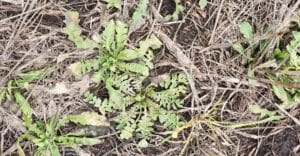Don’t let early weeds get the upper hand

Early season weeds may surprise growers who didn’t realize there was enough late-season moisture last fall for a strong flush of winter annuals, especially in fields that missed a pre-harvest dry-down. Investing in early and effective weed control always pays, especially this year with higher herbicide prices. Smaller weeds are easier to control with lower rates, and early control conserves soil moisture – critical where moisture is in short supply. Pre-seed burndown should occur as soon as weeds are actively growing. GET OUT AND SCOUT. With an effective pre-seed application, growers will be able to consider only one in-crop application. (Pre-seed burnoff: tips for best results) (Spring frost: when to resume weed control) (Major weeds of Canola) (Weed competition: the second application)
Time for a sprayer spa day
Effective spraying depends on a clean and ready-to-roll sprayer. Residue can last in sprayer tanks even after months of storage, so preparation starts with a thorough cleaning. The most common differentiator between a ‘good enough’ and a really great cleaning job? Let the sprayer soak a full 24 hours. After cleaning, thoroughly check for and replace worn nozzles. Now is also the time to plan for and set-up record keeping systems for the spraying season ahead, whether via digital tools or old-school pen and paper. (Spring cleaning for the sprayer) (Sprayers101: Sprayer retrofits – including to improve clean-out)
Safe seed-placed fertilizer
Toxicity and salt effect from nitrogen and potassium-based fertilizers can damage canola seed and seedlings and reduce seed’s ROI. One way to increase canola emergence rates is to keep all fertilizer out of the seed row except for a safe starter rate of 15-20 lb./ac. of P2O5. Seed-placed fertilizer is especially risky in dry soil. (Risk of seed placed fertilizer on canola emergence) (Video: seed placed fertilizer) (Choose the right placement for nitrogen and phosphorus fertilizer applications) (AAFC weather maps including soil moisture)
What’s actually in that soil?
The recent precipitation in the eastern Prairies likely led to run-off in some areas and could lead to eventual leaching and denitrification as the soil thaws and warms up , leaving farmers without the nutrient carryover they might think they have. Try a couple of soil samples this spring in a few target areas that showed high nutrient carryover in samples collected last fall. Results from these targeted samples may come too late to change nutrient application decisions at seeding, but can help inform in-crop applications. (Soil testing for nutrient content) (Podcast 02/28/2020: Six options for nitrogen application in the spring)
